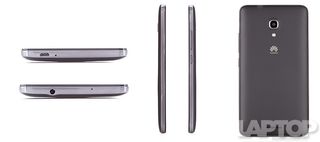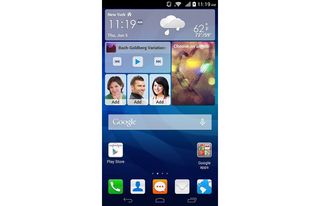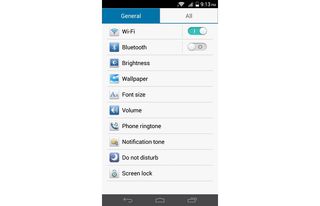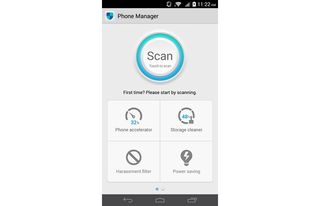Laptop Mag Verdict
Huawei's 6.1-inch Ascend Mate 2 4G LTE offers a big display and nearly 15 hours of battery for just $299 without a contract, making it a strong value.
Pros
- +
Affordable no-contract price
- +
Incredibly long battery life
- +
Doubles as device charger
- +
Big and vibrant display
Cons
- -
Relatively low-resolution screen
- -
Interface can feel cluttered
- -
Camera struggles in low light
Why you can trust Laptop Mag
In the market for a phablet but don't want to deal with a contract? Huawei's Ascend Mate 2 4G LTE might be the answer. At 6.1 inches, the Ascend Mate 2 offers one of the largest displays on the market. And with nearly 15 hours of battery life, this is the longest-lasting smartphone we've ever tested. The Ascend Mate 2 even doubles as a charger for your other devices. At just $299 unlocked, there are plenty of reasons to scoop up this monolithic monster.
Design
If you like seeing movies and websites on a big screen (or have an inferiority complex), the gargantuan Ascend Mate 2 should be right up your alley. At a massive 6.3 x 3.3 x 0.37 inches, the Ascend Mate 2 makes Samsung's 5.7-inch Galaxy Note 3 (6.0 x 3.1 x 0.33 inches) look downright Lilliputian.

That said, Samsung's ludicrously large 6.3-inch Galaxy Mega dwarfs the Ascend, at 6.6 x 3.5 x 0.31 inches. HTC's ginormous 5.9-inch One Max comes in at a similarly bulky 6.5 x 3.2 x 0.41 inches.
Not only is the Ascend Mate 2 among the biggest phablets out there, it's also one of the heaviest. At 7.1 ounces, the Mate 2 is a bit heavier than the 7-ounce Galaxy Mega. Both handsets, though, are considerably lighter than the metal 7.7-ounce One Max.
Beyond its considerable bulk, the Ascend Mate 2 is a relatively attractive handset. Its removable rear panel features a black, soft-touch material that provides a decent grip and sports a white Huawei logo. The handset's edges get a deep gray paint job, while its face is coated in a glossy black finish. Above the phone's huge display is its 5-megapixel selfie camera.
There are no physical buttons on the Ascend Mate 2's face, as the phablet instead uses on-screen navigation keys. The Ascend's power button and volume rocker are situated on its right edge, making them easier to reach with your thumb. The phone's 3.5mm phone jack sits on its top edge, while the microUSB port is on the bottom.
Display

Click to EnlargeIf you're going to strap a massive 6.1-inch display to a smartphone, you might expect it to sport full HD resolution. That's not the case here, however, as Huawei opted for a lower-res 720p panel to keep costs down.
Despite its relatively low resolution, the Ascend Mate 2's display offered clear, vibrant images and videos. The trailer for "Guardians of the Galaxy" looked beautiful on the phablet's huge screen, as Rocket Raccoon's orange prison jumpsuit and green lasers from a massive aerial battle appeared to pop off the display. However, whites viewed on Ascend Mate 2's screen had a distinctly yellow tint when compared to the Galaxy Mega's display.

Click to EnlargeThe Ascend Mate 2's screen displayed 98.9 percent of the sRGB color gamut. That's a hair better than the Galaxy Mega's 97 percent, and much better than the HTC One Max's 89.7 percent. All three phablets, however, fall below the smartphone category average of 118 percent.
The colors that the Ascend Mate 2 does display are fairly accurate. Using our colorimeter, the handset registered a Delta-E rating of 4.3 (0 is perfect). That's about even with the Galaxy Mega's 4.2, and better than the category average of 5.29. The HTC One Max's screen was far less accurate, with a Delta-E rating of 9.5.
Other than sheer size, the Ascend Mate 2's screen stands out because of its brightness. The display hit 420 nits on our light meter, which is well above the smartphone category average of 352 nits. The Galaxy Mega's display reached 365 nits, while the One Max's topped out at 402.
Audio
The Ascend Mate 2 features a single rear-mounted external speaker capable of pumping out 82 decibels of sound. That's better than the smartphone category average of 80 dB, and even with the Galaxy Mega's rating. The HTC One Max, however, was the loudest, registering 83 dB.
The Mate 2's audio quality was too tinny for our liking. Bass-heavy songs such as French Montana's "Pop That" sounded flat, while guitar riffs were a bit too harsh. The Galaxy Mega offered noticeably better audio performance, but it was the HTC One Max and its dual front-mounted speakers that sounded the best, producing deep bass hits and excellent highs.
Interface

Click to EnlargeThe Ascend Mate 2 runs Google's previous generation Android 4.3 Jelly Bean and features Huawei's proprietary Emotion UI 2.0 Lite skin. The interface differs dramatically from pure Android in that it doesn't include a traditional apps drawer, but instead puts all of your apps on one of the Ascend's nine available home screens. You can put your apps into folders to help better organize them.
Unfortunately, the Ascend Mate 2's main home screen is far too cluttered for our liking. From top to bottom, there's a time and weather widget, music player, photo album widget, favorite contacts widgets, Google search bar, Play Store shortcut and Google apps folder. Below those options are five omnipresent shortcuts for the Phone, Contacts, Messages, Email and Browser apps. It's a jumble of icons and widgets you'll probably want to clean up.

Click to EnlargeThe handset's quick settings drawer features nine customizable controls, including Wi-Fi, Bluetooth, GPS, Brightness and Volume. Tapping the More button gives you the ability to switch out one of the original settings for seven additional options, ranging from Profiles and One-hand UI to Gloves Mode.
Huawei has also broken up the Ascend Mate 2's Settings menu into two sections, General and All. The General section provides access to 10 basic options, including Wi-Fi, Wallpaper, Font Size, Screen Lock and others. The Settings menu's All section provides users with a more comprehensive list of options.
If you're interested in a simpler version of the Emotion UI, you can change the handset's home screen style to Simple mode, which replaces the apps' icons with a series of large blocks with easier to read text. Huawei means for this mode to be used by first-time smartphone users and the elderly, though it can be useful for longtime users looking for a more simplified version of Android.
Performance

Click to EnlargeBefitting its mid-tier price, Huawei packed the Ascend Mate 2 with a 1.6-GHz quad-core Qualcomm Snapdragon 400 processor and 2GB of RAM. We did notice a hint of a slowdown while playing the resource-intensive "N.O.V.A. 3," but that was only during times when we were surrounded by hordes of enemies. Beyond that, the Ascend was relatively speedy and responsive.
Speaking of "N.O.V.A. 3," the Ascend Mate 2 loaded the game in 16 seconds, which is on a par with the smartphone category average, and about even with the dual-core Snapdragon 400-powered Galaxy Mega's 15 seconds.
The Ascend Mate 2 took a more leisurely 12 minutes and 48 seconds to complete our VidTrim test, which involves transcoding a 204MB, 1080p video to 480p. That's considerably slower than the Galaxy Mega's time of 9:15 and about 5 minutes longer than the category average.
Unsurprisingly, the Mate 2 offered similar results on various synthetic benchmarks. On the Geekbench 3 test, which measures a device's multicore CPU performance, the Huawei scored 1,486. That's better than the Galaxy Mega's 1,098, but lower than the smartphone category average of 1,806.
On the Quadrant benchmark, which tests a device's overall system performance, the Ascend Mate 2 notched 10,658, beating the Mega's score of 8,204, but falling behind the category average of 12,780.
The Ascend Mate 2 scored 4,844 on the 3DMark Ice Storm Unlimited graphics test, which was better than the Mega's 4,552.
Camera
The Ascend Mate 2's 13-megapixel rear camera captured fairly sharp, colorful photos outdoors. A shot of a flower pot was clean and colors were accurate. The Galaxy Mega's 8-megapixel camera shot equally clear photos, though colors had a bluer tint than we would have liked.
When we zoomed in 100 percent on photos, they began to lose their crispness, but chances are most users won't view their shots at full size. Images taken with the HTC One Max's Ultrapixel camera were dimmer than those taken with both the Huawei and Samsung.
Unfortunately, the Ascend Mate 2 fell flat on its face in low light. A photo of a young woman taken without the flash was far too dark, making our subject hard to see. We saw passable results with the flash on, but details looked soft around the subject's skin.

A 1080p video shot with the Mate 2's rear camera offered lush colors, though details were lacking. Portions of a nearby tree looked blurry, while buildings looked like they had a slight haze over them. The Galaxy Mega's video, on the other hand, made colors look flat, but details were crisp and clear.
[sc:video id="tnd3E1cTr4YE0Z-KlSl3uF25g5UnTbBo" width="575" height="398"]
The Ascend Mate's 5-MP front camera captured detailed and colorful photos of our subject, his red beard contrasting nicely with his blue eyes. For group selfies, Huawei offers a Groufie mode. (No, that's not a joke.) Groufie works like a panorama; you take a center picture, followed by shots to the left and right. Make a mistake, though, and your friend's arm may end up sticking out of someone's head.
Apps

Click to EnlargeHuawei has done well to keep the preloaded apps to a minimum on the Ascend Mate 2. Beyond the standard array of first-party Google apps, Huawei offers 20GB of free storage service via Bitcasa, as well as the aptly named navigation app, Navigate.
The Phone Manager app can help you better monitor the device's performance by showing you which apps are running and how much memory they're using. You can also block messages and phone calls from specific numbers and adjust the Ascend Mate 2's power plan.
Battery Life
One of the Ascend Mate 2's biggest draws is its massive 3,900 mAh battery. On the Laptop Mag Battery Test, which involves continuous Web surfing over 4G LTE with the display brightness set to 150 nits, the Ascend Mate 2 lasted a marathonlike 14 hours and 43 minutes on AT&T's LTE network. That makes this the longest-lasting smartphone we've ever tested.
MORE: 10 Smartphones with the Longest Battery Life
To put that runtime in perspective, the Ascend Mate 2's battery lasted nearly twice as long as the smartphone category average of 7:30. The Galaxy S5 on AT&T endured for 9:42 and the HTC One M8 for Verizon lasted 10 minutes longer than that.
The Ascend Mate 2 lets you make the most of its extra juice by doubling as a charger for other mobile devices. To charge another smartphone, tablet or other gadget from the Mate 2, you'll need to spring for a $9.99 microUSB-to-microUSB cable.
Bottom Line

Click to EnlargeThe Huawei Ascend Mate 2 4G LTE is a quality big-screen smartphone at a very tempting price. For $299 unlocked, you get a massive 6.1-inch display that, while not full HD, is bright and colorful. The midrange processor offers fairly zippy performance. This phablet's biggest strength is its 15 hours of battery life, which blows away all other devices. We just wish the camera took better photos in low light.
There are other cheap Android phones for less than $300. For instance, the Moto G with LTE costs $219. It offers a smaller 4.5-inch, 720p screen, a 1.2-GHz Snapdragon 400 processor and a 5-MP camera. But if you want a no-contract phone with a large display, the Ascend Mate 2 is one of the better values of the year.
Huawei Ascend Mate 2 4G LTE Specs
| Bluetooth Type | Bluetooth 4.0 |
| Brand | Huawei |
| CPU | 1.6-Ghz quad-core Qualcomm Snapdragon 600 |
| Camera Resolution | 13MP |
| Carrier | Unlocked |
| Company Website | www.huawei.com |
| Data | GSM, UMTS/HSPA+, LTE |
| Display (main) | 6.1-inch 1280 x 720 resolution IPS display |
| Display Resolution | 1280x720 |
| Form Factor | Candybar Touchscreen |
| Front Camera Resolution | 5 MP |
| GPS | Yes |
| Internal Memory | 16GB |
| Memory Expansion Type | microSD Card |
| OS Family | Android |
| Operating System | Android 4.3 |
| Phone Display Size | 6.1 |
| Ports | SIM card slot, microUSB, microSD, 3.5mm headphone |
| Processor Family | Qualcomm Snapdragon 600 |
| RAM | 2GB |
| Size | 6.4 x 3.3 x 0.37 inches |
| Weight | 7.1 ounces |
| Wi-Fi | 802.11 a/b/g/n/ac |
